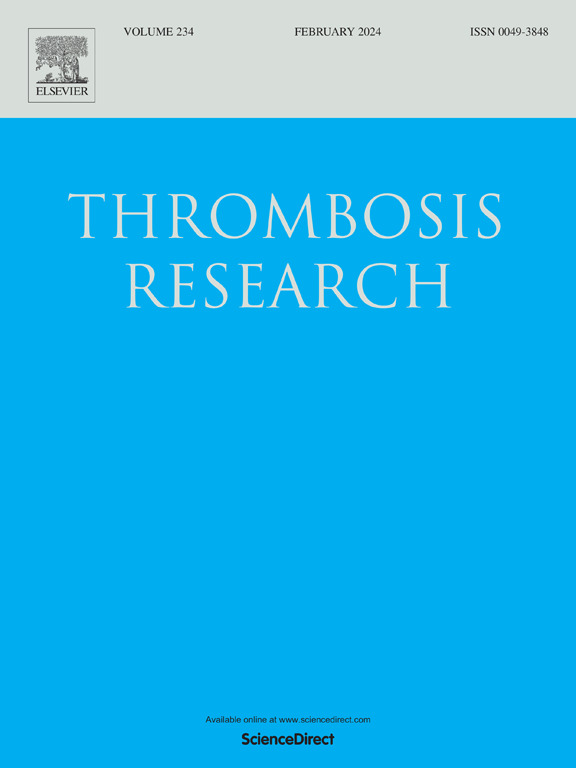Phenotype, genotype, and laboratory assessment of congenital fibrinogen disorders: Data from the Rare Bleeding disorders in the Netherlands study
IF 3.7
3区 医学
Q1 HEMATOLOGY
引用次数: 0
Abstract
Introduction
Congenital fibrinogen disorders (CFDs), encompassing quantitative (hypo−/afibrinogenemia) and qualitative (dysfibrinogenemia) defects, can result in bleeding or thrombotic events. This study aimed to enhance understanding of the clinical and genetic characteristics of CFD patients.
Methods
The Dutch cross-sectional RBiN study included 47 CFD patients (median age 38, 55 % women), categorized into (hypo)dysfibrinogenemia, severe (<500 mg/L), moderate (500–1000 mg/L) and mild hypofibrinogenemia (1000–1800 mg/L) as well as carriers with pathogenic variants but normal fibrinogen levels (>1800 mg/L). Clinical assessments included bleeding phenotype, thrombosis history, fibrinogen activity and antigen levels, thrombin and plasmin generation assays and genotypic analysis.
Results
Patients with severe hypofibrinogenemia displayed the highest median ISTH-BAT score (16), followed by moderate hypofibrinogenemia (11), (hypo)dysfibrinogenemia (6), mild hypofibrinogenemia (4) and carriers (0). Female-specific bleeding (postpartum hemorrhage, heavy menstrual bleeding) was prevalent across all CFD subtypes, with moderate hypofibrinogenemia showing high average scores on these ISTH-BAT items (3.0 and 2.3). Postoperative bleeding was common in moderate and severe hypofibrinogenemia (average ISTH-BAT item scores of 2.5 and 2.8, respectively). Patients with biallelic variants had lower fibrinogen activity levels (median 200 mg/L) than those with monoallelic variants (935 mg/L, p < 0.001). Fibrinogen activity levels correlated positively with plasmin peak height (R = 0.74, p < 0.001) and inversely with thrombin potential (R = –0.55, p = 0.002). Thrombin potential was 1.77-fold higher in patients with a venous thrombosis history (n = 5, p = 0.03) than in healthy controls.
Conclusions
In patients with CFDs, postoperative bleeding correlates with fibrinogen activity, while female-specific bleeding affects all CFD subtypes. Elevated thrombin generation might explain thrombosis risk in these patients.
先天性纤维蛋白原疾病的表型、基因型和实验室评估:来自荷兰罕见出血性疾病研究的数据
先天性纤维蛋白原疾病(CFDs),包括定量(低/纤维蛋白原血症)和定性(纤维蛋白原异常血症)缺陷,可导致出血或血栓事件。本研究旨在提高对CFD患者临床和遗传特征的认识。方法荷兰横断RBiN研究纳入47例CFD患者(中位年龄38岁,55%为女性),分为(低)纤维蛋白原异常血症、严重(500 mg/L)、中度(500 - 1000 mg/L)和轻度低纤维蛋白原血症(1000-1800 mg/L)以及携带致病变异但纤维蛋白原水平正常(1800 mg/L)的携带者。临床评估包括出血表型、血栓史、纤维蛋白原活性和抗原水平、凝血酶和纤溶酶生成测定和基因型分析。结果严重低纤维蛋白原血症患者的ISTH-BAT中位数得分最高(16分),其次是中度低纤维蛋白原血症(11分)、(低)异常纤维蛋白原血症(6分)、轻度低纤维蛋白原血症(4分)和携带者(0分)。女性特异性出血(产后出血、重度月经出血)在所有CFD亚型中普遍存在,其中中度低纤维蛋白原血症在ISTH-BAT项目上的平均得分较高(3.0分和2.3分)。术后出血在中度和重度低纤维蛋白原血症中很常见(平均ISTH-BAT项目评分分别为2.5和2.8)。双等位基因变异患者的纤维蛋白原活性水平(中位数为200 mg/L)低于单等位基因变异患者(中位数为935 mg/L, p <;0.001)。纤维蛋白原活性水平与纤溶酶峰高呈正相关(R = 0.74, p <;0.001),与凝血酶电位呈负相关(R = -0.55, p = 0.002)。有静脉血栓形成史的患者凝血酶电位比健康对照组高1.77倍(n = 5, p = 0.03)。结论在CFD患者中,术后出血与纤维蛋白原活性相关,而女性特异性出血影响所有CFD亚型。凝血酶生成升高可能是这些患者血栓形成风险的原因。
本文章由计算机程序翻译,如有差异,请以英文原文为准。
求助全文
约1分钟内获得全文
求助全文
来源期刊

Thrombosis research
医学-外周血管病
CiteScore
14.60
自引率
4.00%
发文量
364
审稿时长
31 days
期刊介绍:
Thrombosis Research is an international journal dedicated to the swift dissemination of new information on thrombosis, hemostasis, and vascular biology, aimed at advancing both science and clinical care. The journal publishes peer-reviewed original research, reviews, editorials, opinions, and critiques, covering both basic and clinical studies. Priority is given to research that promises novel approaches in the diagnosis, therapy, prognosis, and prevention of thrombotic and hemorrhagic diseases.
 求助内容:
求助内容: 应助结果提醒方式:
应助结果提醒方式:


